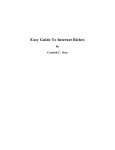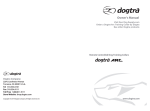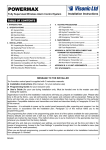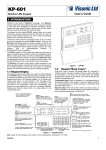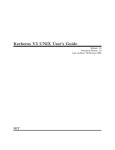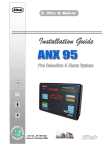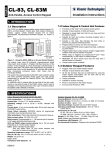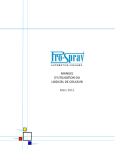Download WST-400 Smoke User Manual
Transcript
:67
Wireless Smoke Detector
Owner‘s Manual
%DVLF ,QIRUPDWLRQ
•
•
•
•
•
Put the detector as close to the ceiling center as possible.
Put detectors outside of every bedroom area and on every
level of your home.
Test all detectors weekly, one at a time, by holding in each
test switch button on the cover for about 20 seconds until the
alarm sounds.
If the LED on your detector flashes about 4 times per minute,
it is receiving power from the power supply.
If your alarm beeps once a minute, it needs a new battery.
:KDW 6PRNH 'HWHFWRUV 'R
:KHUH 6PRNH 'HWHFWRUV 6KRXOG %H /RFDWHG
Smoke detectors are designed to provide early warning of
developing fires at a reasonable cost. They monitor the air and
can sense smoke and can provide precious minutes for you and
your family to escape before a fire spreads.
This smoke detector should be installed in accordance with the
National Fire Protection Association, Standard 74 (National Fire
Protection Association, Batterymarch Park, Quincy, MA 02269).
This standard means that for complete coverage, smoke
detectors should be installed in all rooms, halls, storage areas,
basements, and attics of a building. The minimum recommendation is one detector on each level of a building and one in every
sleeping area. See how this recommendation applies in the
figures below.
A. Put a smoke detector in the hallway outside of every separate
bedroom area (Fig. 1). Two detectors are required in homes
with two bedroom areas (Fig. 2).
B. Put a smoke detector on every level of a multi-level residence
(Fig. 3).
CAUTION: Early warning fire detection is best achieved by the
installation of fire detection equipment in all rooms and areas of
the household as follows: A smoke detector installed in each
separate sleeping area (in the vicinity, but outside the
bedroom), and heat or smoke detectors in the living rooms,
dining rooms, bedrooms, kitchens, hallways, attics, furnace
rooms, closets, utility and storage rooms, basements and
attached garages.
:KDW 6PRNH 'HWHFWRUV &DQQRW 'R
Smoke detectors will not work without power. Battery-operated
detectors will not work without batteries, with dead batteries, or if
the batteries are not put in properly. AC-powered detectors will
not work if their AC power supply is cut off by an electrical fire, an
open fuse or circuit breaker, or for any other reason. If you are
concerned about the reliability of either batteries or your AC
power supply for any of the above reasons, you should install
both battery and AC powered detectors for maximum safety.
Smoke detectors may not sense fires that start where smoke
cannot reach the detectors such as in chimneys, in walls, on
roofs, or on the other side of closed doors. If bedroom doors are
usually closed at night, detectors should be placed in each
bedroom as well as in the common hallway between them.
Smoke detectors also may not sense a fire on another level of the
residence or building. For example, a second-floor detector may
not sense a first-floor or basement fire. Therefore, detectors
should be placed on every level of a residence or building.
The horn in your detector meets or exceeds current audibility
requirements of Underwriters Laboratories. However, if the
detector is located outside a bedroom, it may not wake up a
sound sleeper, especially if the bedroom doors are closed or only
partly open. If the detector is located on a different level of the
residence than the bedrooms, it is even less likely to wake up
people sleeping in the bedrooms. In such cases, the National Fire
Protection Association recommends that the detectors be
interconnected so that all detectors sound an alarm when any
one detector senses smoke.
All types of smoke detector sensors have limitations. No type of
smoke detector can sense every kind of fire every time. In
general, detectors may not always warn you about fires caused
by carelessness and safety hazards like smoking in bed, violent
explosions, escaping gas, improper storage of flammable
materials, overloaded electrical circuits, children playing with
matches, or arson.
Installing smoke detectors may make you eligible for lower
insurance rates, but smoke detectors are not a substitute for
insurance. Homeowners and renters should continue to insure
their lives and property.
DE3541U
Figure 1: Recommended Smoke Detector for Single-Floor
Residence with Only One Sleeping Area.
Figure 2: Recommended Smoke Detector Protection for
Single-Floor Residence with More than One Sleeping Area.
C. Put a smoke detector inside bedrooms where smokers sleep.
D. Put a smoke detector inside every bedroom where electrical
appliances (such as portable heaters or humidifiers) are
operated while someone sleeps.
1
.
Figure 3: Recommended Smoke Detector Protection for a
Multilevel Residence
E. Put a smoke detector inside every bedroom where
someone sleeps with the door closed. Smoke could be
blocked by the closed door, or the alarm may not wake the
sleeper if the door is closed.
F. Put detectors as close to the center of the ceiling as
possible. If this is not practical, put the detector on the
ceiling, but no closer than 10 cm (4 in.) to any wall or
corner (Fig. 4).
Figure 4: Recommended Smoke Alarm Mounting Locations
G. If wall mounting is permitted by your local and state codes, put
wall-mounted detectors between 10 and 15 cm (4 and 6
inches) from the ceiling ( Fig. 4).
H. Put smoke detectors at both ends of a bedroom hallway if
the hallway is more than 12 m (40 ft) long.
I. Put basement alarms at the bottom of the basement
stairwell.
J. Put second-floor alarms at the top of the first-to-second
floor stairwell, as long as no other door or other
obstruction blocks the path of smoke to the alarm.
Figure 5: Recommended Smoke Alarm Mounting Locations in
Rooms with Sloped, Gabled or Peaked Ceiling
K. In rooms with sloped, peaked, or gabled ceilings, mount
detectors 0.9 m (3 ft) measured horizontally from the
highest point of the ceiling ( Fig. 5).
:KHUH 6PRNH 'HWHFWRUV 6KRXOG %H /RFDWHG
LQ 0RELOH +RPHV DQG 59·V
detectors should be installed as described in the section above.
In older mobile homes and RV’s that have little or no insulation
compared to today’s standards, uninsulated metal outside walls
and roofs can transfer heat and cold from outdoors, making the
air right next to them hotter or colder than the rest of the inside
air. These layers of hotter or colder air can prevent smoke from
reaching a smoke alarm. Therefore, put smoke detectors in such
units only on inside walls, between 10 and 15 cm (4 and 6
inches) from the ceiling. If you are not sure about the insulation
level in your mobile home or RV, or if you notice that the walls or
ceilings are unusually hot or cold, put the alarm on an inside wall.
Minimum protection requires one alarm as close to the sleeping
area as possible. For better protection, put one detector in each
room, but first read Section 6 - “Where Smoke Detectors Should
Not be Put”.
:KHUH 6PRNH 'HWHFWRUV 6KRXOG 1RW %H 3XW
Nuisance alarms are caused by placing alarms where they will
not operate properly. To avoid nuisance alarms, do not place
detectors:
A. In or near areas where combustion particles are normally
present such as kitchens; in garages where there are particles
of combustion in vehicle exhausts; near furnaces, hot water
heaters, or gas space heaters. Install detectors at least 6 m
(20 ft) away from kitchens and other areas where combustion
is normally present.
B. In air streams passing by kitchens. Figure 6 shows how a
detector can be exposed to combustion particles in normal air
movement paths, and how to correct this situation.
C. In damp or very humid areas, or next to bathrooms with
showers. The moisture in humid air can enter the sensing
chamber as water vapor, then cool and condense into droplets
that cause a nuisance alarm. Install alarms at least 1.5 m (5
ft) away from bathrooms.
D. In very cold or very hot environments, or in unheated buildings
or outdoor rooms, where the temperature can go below or
above the operating range of the detector. Temperature limits
for proper operation are 4° to 38°C (40° to 100°F).
E. In very dusty or dirty areas. Dust and dirt can build up on the
detector’s sensing chamber and make it overly sensitive, or
can block openings to the sensing chamber and keep the
detector from sensing smoke.
F. Near fresh air inlets or returns or excessively drafty areas. Air
conditioners, heaters, fans, and fresh air intakes and returns
can drive smoke away from smoke detectors, making the
detectors less effective.
Figure 6: Recommended Smoke Alarm Locations to Avoid Air
Streams with Combustion
G. In dead air spaces at the top of a peaked roof or in the
corners between ceilings and walls. Dead air may prevent
smoke from reaching a detector. See Figures 4 and 5 for
recommended mounting locations.
H. In insect-infested areas. If insects enter a detector’s sensing
chamber, they may cause a nuisance alarm. Get rid of the
bugs before installing detectors where bugs are a problem.
I. Near fluorescent light fixtures. Electrical “noise” from nearby
fluorescent light fixtures may cause a nuisance alarm. Install
detectors at least 3 m (10 ft) away from such light fixtures.
In mobile homes and recreational vehicles built after about 1978
that were designed and insulated to be energy-efficient, smoke
2
DE3541U
+RZ WKH 6PRNH $ODUP 6KRXOG %H 3XW 8S
After you have read the sections on “Where Smoke Detectors
Should Be Located” and “Where Smoke Detectors Should Not Be
Put” (Sections 4-6), you should have decided where to install this
alarm.
To mount the alarm on the ceiling (or wall), please follow these
steps:
A. Place the alarm against the ceiling (or wall) where you want
the alarm to be. (For wall mounting, position the alarm so that
the indicator light will be at the bottom where it will be easiest
to see.)
B. Turn the alarm over and remove the mounting bracket by
turning it counterclockwise. Hold the bracket against the
ceiling (or wall) with a pencil, trace around the inside of the
two screw slots (Fig. 7).
THE WST-400 CONSISTS OF A SMOKE DETECTOR
MANUFACTURED BY A WELL KNOWN SMOKE DETECTOR
COMPANY,
AND
THE
WIRELESS
TRANSMITTER
MANUFACTURED BY VISONIC LTD.
IT IS THE INSTALLING COMPANY’S RESPONSIBILITY TO
INVESTIGATE THE REGULATIONS SET FORTH BY ANY
LOCAL, STATE OR OTHER AUTHORITY HAVING
JURISDICTION PERTAINING TO WIRELESS SMOKE
DETECTOR USE AND INSTALLATION.
+RZ WR 7HOO LI WKH 'HWHFWRU LV :RUNLQJ 5LJKW
The alarm horn and the indicator light on your smoke alarm let
you know whether the alarm is working right. Table 1 below will
help you determine the alarm’s status.
Table 1: DETECTOR STATUS
Alarm Status
Functioning Normally
Electronic Horn
Silent
Indicator Light
Flashing about 4
Times per minute
Flashing about 4
Times per minute
Low Battery or Alarm Beeping Once
Malfunction. Replace per Minute
Battery
Sounding Alarm;
On Continuously Flashing Rapidly
Detecting Smoke
(Steady Pulse)
Sounding Alarm;
On Continuously Flashing about 4
Smoke Sensed by a
(Steady Pulse)
times per minute
Connected Detector
Note: The alarm will automatically turn off when the smoke in the
air is completely gone. If the alarm is caused by a nuisance
condition such as cooking smoke, open a window or fan the air
around the alarm to remove the smoke. Do not disconnect the
battery; this will remove your protection.
+RZ WR 7DNH &DUH RI <RXU 'HWHFWRU
Figure 7: Installation
C. Put the alarm where it won’t get dust on it from the holes to be
drilled in the ceiling (or wall).
D. Using a 5 mm (3/16 inch) drill bit, drill holes approximately in
the centers of the two slots outlined on the ceiling (or wall).
E. Push the plastic screw anchors (in the package with the
screws) into the holes so that the tops are flat against the
ceiling (or wall).
F. Using the two screws, tightly fasten the mounting bracket to
the ceiling (or wall).
G. Insert the battery into the brackets by pushing the top of the
battery down into the cavity and snapping the battery into
place. (The positive or male terminal goes closest to the
center of the alarm.)
CAUTION: The battery must be inserted correctly or alarm
will not work.
H. Depress the test button on the cover, and hold it in for up to
20 seconds or until the alarm horn sounds. The horn should
sound a loud pulsating alarm and the indicator light should
flash rapidly. This indicates that the alarm is working properly.
If the alarm horn does not sound, check to make sure the
battery is inserted correctly.
I. Mount the alarm by aligning the locating nibs on the cover with
the arrows on the mounting bracket and turning the alarm
clockwise until a positive snap is felt.
J. Retest the alarm to make sure it works. Press the test button
and hold it down for up to 20 seconds until the alarm horn
sounds.
7DPSHU 5HVLVWDQW 0RXQWLQJ
The alarm mounting may be made tamper-resistant by breaking
off the plastic tab as shown in the Figure 7. To release an alarm
mounted in this way, push-up on the locking tab with a small
screwdriver while turning the alarm counter-clockwise.
DE3541U
Your smoke detector has been designed to be as
maintenance-free as possible. To keep your detector in good
working order, you must:
A. Test the detector weekly by pressing on the test switch for
up to 20 seconds until the alarm sounds.
WARNING: In RV’s, test the detector after storage and
before each trip.
WARNING: Never use an open flame of any kind to test
your detector. You may ignite and damage the alarm as
well as your home. The built-in test switch accurately
simulates smoke and tests all alarm functions, as required
by Underwriters’ Laboratories of Canada.
B. Replace the battery once a year or immediately when the
Low Battery “beep” signal sounds once per minute. The
Low Battery signal should last at least 30 days.
This detector uses standard nine-volt batteries. The detector
will work properly with the following batteries:
Eveready #552
Duracell #MN1604
WARNING: Do not use any other kind of battery. The
detector may not operate properly with other batteries. If you
experience repeated nuisance alarms, check the alarm
location under “Where Smoke Detectors Should Not Be
Put.”
Move your detector if it is not properly located and clean it as
described below. Improperly located and dirty detectors are
the major cause of nuisance alarms.
C. Vacuum the dust off the detector sensing chamber at
least once a year. This can be done when you remove the
detector to replace the battery. Remove the battery before
cleaning. Use a soft brush attachment and carefully remove
any dust on the openings of the sensing chamber at the top of
the detector and the openings between the base and the
cover. Replace the battery after cleaning.
D. Clean the detector’s cover when it becomes dirty. First
remove the battery. Then hand wash the cover with a cloth
dampened with mild soapy water, rinse it with a cloth
3
dampened with clear water, and dry it with a lint-free cloth.
Be careful not to get any water into the openings where it
can get on the detector components. Replace the battery.
E. Test the detector after closing the cover whenever you
have opened it to replace the battery or clean it.
WARNING: If the detector does not work properly, make
sure that the battery is fresh and is connected correctly, and
that the openings to the sensing chambers are clean. If there
is still a problem, do not try to fix the detector yourself.
This will void your warranty. Send the detector to Visonic
Inc., 10 Northwood Drive, Bloomfield CT 06002. Enclose a
note describing what is wrong with the detector in the
package with the detector.
:KDW (OVH &DQ <RX 'R WR 0DNH <RXU )DPLO\
6DIHU )URP )LUHV
Putting up smoke detectors is just the first step in a protecting
your family from fires. You also must reduce the chances that
fires will start in your home and increase your chances of safely
escaping if one does start. To have an effective fire safety
program:
A. Install smoke detectors properly following the
instructions in this manual. Keep your smoke detectors
clean and replace the batteries when required. Test your
detector weekly and repair or replace it when it no longer
functions. As with any electronic product, smoke detectors
have a limited life, and detectors that don’t work cannot
protect you.
B. Follow safety rules and prevent hazardous situations.
1. Use smoking materials properly; never smoke in bed.
2. Keep matches and cigarette lighters away from children.
3. Store flammable materials in proper containers and never
use them near open flames or sparks.
4. Keep electrical appliances and cords in good working
order and do not overload electrical circuits.
5. Keep stoves, fireplaces, chimneys, and barbeque grills
grease-free and make sure they are properly installed
away from combustible materials.
6. Keep portable heaters and open flames such as candles
away from combustible materials.
7. Do not allow rubbish to accumulate.
C. Develop a family escape plan and practice it with your
entire family, especially small children.
1. Draw a floor plan of your home and find two ways to exit
from each room. There should be one way to get out of
each bedroom without opening the door.
2. Teach children what the smoke alarm alarm signal
means, and that they must be prepared to leave the
residence by themselves if necessary. Show them how to
check to see if doors are hot before opening them, how to
stay close to the floor and crawl if necessary, and how to
use the alternate exit if a door is hot and should not be
opened.
3. Decide on a meeting place a safe distance from your
house and make sure that all your children understand
that they should go and wait for you there if there is a fire.
4. Hold fire drills at least every 6 months to make sure that
everyone, even small children, knows what to do to
escape safely.
5. Know where to go to call the fire department from outside
your residence.
6. Provide emergency equipment such as fire extinguishers
and teach your family to use this equipment properly.
:KDW WR 'R LI WKHUH LV D )LUH LQ <RXU +RPH
A. Don’t panic; stay calm. Your safe escape may depend on
thinking clearly and remembering what you have practiced.
B. Get out of the house following a planned escape route as
quickly a possible. Do not stop to collect valuables or to get
dressed.
C. Open doors carefully only after feeling them to see if they are
hot. Do not open a door if it is hot; use an alternate escape
route.
D. Stay close to the floor; smoke and hot gases rise.
E. Cover your nose and mouth with a cloth, wet if possible, and
take short shallow breaths.
F. Keep doors and windows closed unless you open them to
escape.
G. Meet at your prearranged meeting place after leaving the
house.
H. Call the Fire Department as soon as possible from outside
your house. Give the address and your name.
I. Never re-enter a burning building.
Contact your local Fire Department for more information on
making your home safer from fires and about preparing your
family’s escape plans.
:$55$17<
Visonic Ltd. and/or its subsidiaries and its affiliates ("the Manufacturer") warrants its
products hereinafter referred to as "the Product" or "Products" to be in conformance with
its own plans and specifications and to be free of defects in materials and workmanship
under normal use and service for a period of twelve months from the date of shipment by
the Manufacturer. The Manufacturer's obligations shall be limited within the warranty
period, at its option, to repair or replace the product or any part thereof. The Manufacturer
shall not be responsible for dismantling and/or reinstallation charges. To exercise the
warranty the product must be returned to the Manufacturer freight prepaid and insured.
This warranty does not apply in the following cases: improper installation, misuse,
failure to follow installation and operating instructions, alteration, abuse, accident or
tampering, and repair by anyone other than the Manufacturer.
This warranty is exclusive and expressly in lieu of all other warranties, obligations or
liabilities, whether written, oral, express or implied, including any warranty of
merchantability or fitness for a particular purpose, or otherwise. In no case shall the
Manufacturer be liable to anyone for any consequential or incidental damages for breach
of this warranty or any other warranties whatsoever, as aforesaid.
This warranty shall not be modified, varied or extended, and the Manufacturer does not
authorize any person to act on its behalf in the modification, variation or extension of this
warranty. This warranty shall apply to the Product only. All products, accessories or
attachments of others used in conjunction with the Product, including batteries, shall be
covered solely by their own warranty, if any. The Manufacturer shall not be liable for any
damage or loss whatsoever, whether directly, indirectly, incidentally, consequentially or
otherwise, caused by the malfunction of the Product due to products, accessories, or
attachments of others, including batteries, used in conjunction with the Products.
The Manufacturer does not represent that its Product may not be compromised and/or
circumvented, or that the Product will prevent any death, personal and/or bodily injury
and/or damage to property resulting from burglary, robbery, fire or otherwise, or that the
Product will in all cases provide adequate warning or protection. User understands that a
properly installed and maintained alarm may only reduce the risk of events such as
burglary, robbery, and fire without warning, but it is not insurance or a guarantee that such
will not occur or that there will be no death, personal damage and/or damage to property
as a result.
The Manufacturer shall have no liability for any death, personal and/or bodily injury
and/or damage to property or other loss whether direct, indirect, incidental,
consequential or otherwise, based on a claim that the Product failed to function.
However, if the Manufacturer is held liable, whether directly or indirectly, for any loss or
damage arising under this limited warranty or otherwise, regardless of cause or origin, the
Manufacturer's maximum liability shall not in any case exceed the purchase price of the
Product, which shall be fixed as liquidated damages and not as a penalty, and shall be the
complete and exclusive remedy against the Manufacturer.
Warning: The user should follow the installation and operation instructions and among
other things test the Product and the whole system at least once a week. For various
reasons, including, but not limited to, changes in environmental conditions, electric or
electronic disruptions and tampering, the Product may not perform as expected. The user
is advised to take all necessary precautions for his /her safety and the protection of
his/her property.
6/91
VISONIC LTD. (ISRAEL): P.O.B 22020 TEL-AVIV 61220 ISRAEL. PHONE: (972-3) 645-6789, FAX: (972-3) 645-6788
VISONIC INC. (U.S.A.): 10 NORTHWOOD DRIVE, BLOOMFIELD CT. 06002-1911. PHONE: (860) 243-0833, (800) 223-0020 FAX: (860) 242-8094
VISONIC LTD. (UK): UNIT 1, STRATTON PARK, DUNTON LANE, BIGGLESWADE, BEDS. SG18 8QS. PHONE: (01767) 600857 FAX: (01767) 601098
VISONIC LTD. 1998 WST-400 D-3541-0 NEW : DE3541U (REV. 1, 4/98)
4
DE3541U




